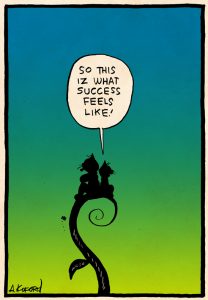 I am one of the instructors for the MyResearch graduate seminar series, which just ended for the autumn semester. It will be offered again in the winter. Issues in scholarly publishing are one of the topics we discuss in MyResearch, such as which factors should we consider for determining the best journal to submit a manuscript.
I am one of the instructors for the MyResearch graduate seminar series, which just ended for the autumn semester. It will be offered again in the winter. Issues in scholarly publishing are one of the topics we discuss in MyResearch, such as which factors should we consider for determining the best journal to submit a manuscript.
I use the following multi-step approach for selecting a journal:
1- With the database search results I exported to EndNote, I sort the relevant references in my EndNote Library by the “Journal” column and pick out a few journals (usually 3-5) that published the most articles on my topic. You can also click on “analyze results” in Web of Science and Scopus to see the list of journals in your results set, listed from the ones with the most articles to the least.
2- I visit each journal’s website, where I read about the scope of the journal and look at the instructions to the authors. This helps me determine whether my article would be considered for publication by the journal. If yes, I move on to the next step.
3- I search for the Journal Impact Factor in Journal Citation Reports (you can also click on the journal name for a result in Web of Science to view the Journal Impact Factor), and then I use the “Compare sources” option in Scopus to search for each journal, which will enable me to look at the journal’s SJR (Scimago Journal Rank) score, SNIP (the citation potential or the average times an article in that journal can expect to be cited in a given year) score, % not cited, and % reviews (review articles usually generate more citations, so if a journal publishes a lot of reviews, this might inflate its SJR and Journal Impact Factor scores). All these metrics are calculated differently but viewed together they tell me a story of which journal has the higher impact, based on more than one criterion.
4- If the journals I’m comparing rank about the same, e.g., let’s say they both fall between the top 25-35% of highly cited journals, I consider other factors, such as:
i) How long will it take before I receive a decision about my manuscript, and what is the journal’s manuscript acceptance rate? (Look at the journal’s website for this information. If you’re short on time to meet a deadline that requires the work to be published, this factor might be very important because you want to give yourself enough time to resubmit to a second journal if the first journal rejects your manuscript.)
ii) In which databases is this journal indexed? (If there are more databases that provide references to articles in the journal, this increases the odds of someone finding a reference to your article and citing it.)
iii) Will the journal allow me to make, at least, a post-print (final text of your manuscript, incorporating changes from peer-review process) freely available on the web within 12 months after publication? (This will allow individuals without a personal or institutional subscription to the journal to be able to read your article without paying for it, and satisfy the Tri-Agency Open Access Policy on Publications for research funded by SSHRC, NSERC, and CIHR. Search the journal in Sherpa Romeo to find this information or look at the journal’s website).
5- By this stage, I have usually narrowed down my list of multiple journals to two journals. At this step, I consider personal preferences. Which of the two journals do I read or use the most, or which one would make me the most proud if I received a letter of acceptance?
This is the seventh in a series of posts about topics relating to research skills and ethics. Happy Halloween!
Image from the Laugh-Out-Loud Cats cartoon strip by Adam “Ape Lad” Koford (creative commons license)
